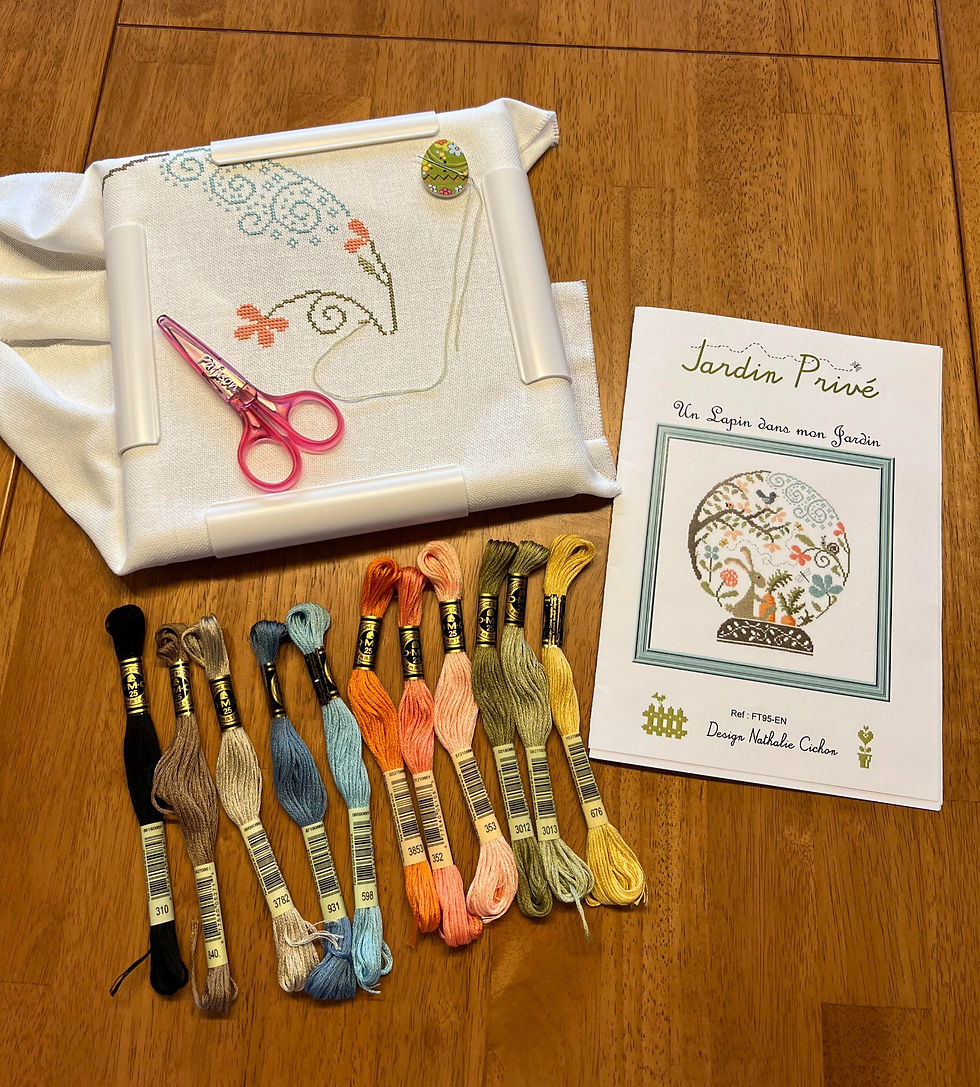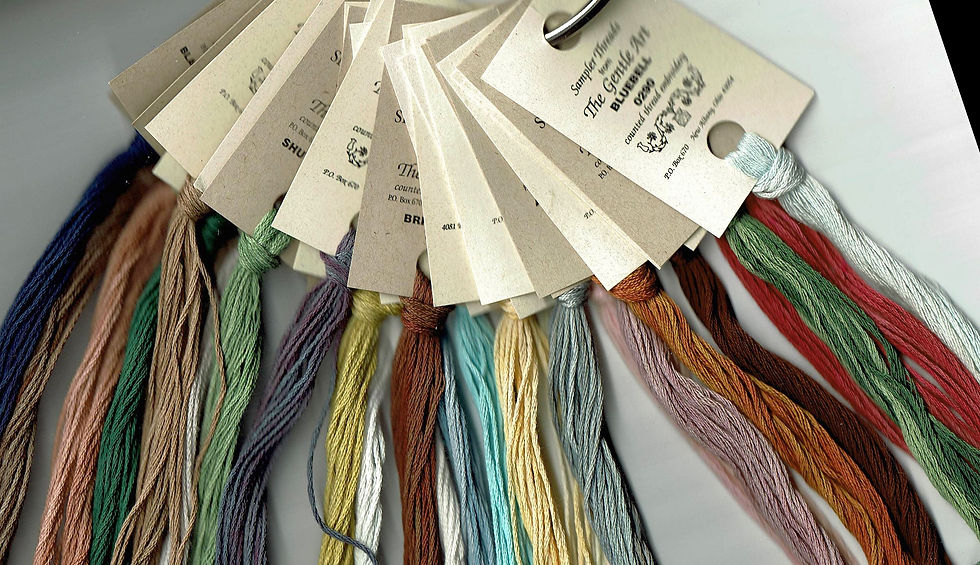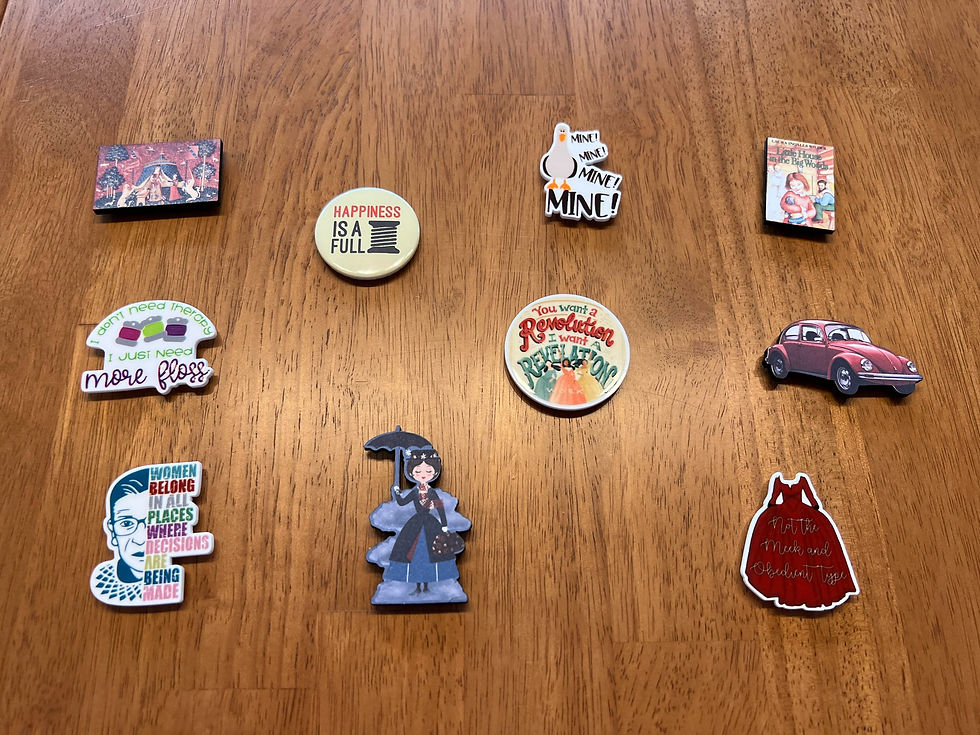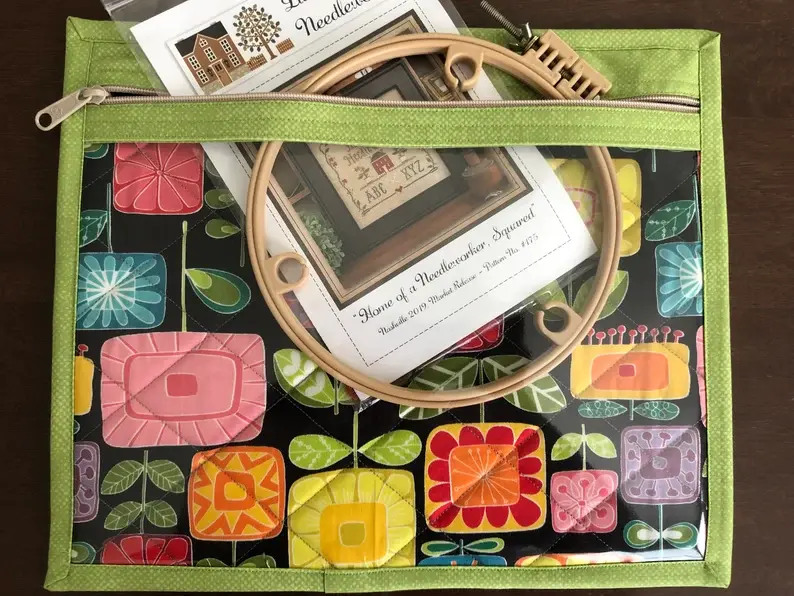Rediscovering My Love of Cross Stitch
- Jodi Blake

- Mar 16, 2023
- 7 min read
Updated: Mar 23, 2023

More than 20 years ago, I was an avid cross stitcher who loved stitching little Xs on fabric to create designs. It was the era of country themes with lots of baskets, geese, teddy bears and hearts and an abundance of mauve and blue colors. I stitched lots of wedding and birth announcements, but then I drifted away from the hobby when I was bit by the quilting bug.
So, imagine my surprise when I discovered that counted cross stitch is still a thriving craft in the 2020s. A couple years ago I stumbled upon a “Flosstube” video on YouTube. (These videos are called Flosstube because cross stitchers use embroidery floss to create their projects.) The woman in the video was sharing her latest progress on several cross stitch projects along with plans for what she wanted to complete before she would record her next video. I really liked what she was working on, so I was anxious to check out more Flosstube videos. Consequently, I was hooked all over again and ready to dive back into this craft.
After following several Flosstubers for the last couple years and beginning to stitch projects again, I picked up on the many ways this craft has evolved since the last time I was buying floss for my daughter to make friendship bracelets during her middle and high school years. Whether you have ever worked on a counted cross stitch project before or you might be interested in trying this type of needlecraft, let me share what’s “new” in this hobby today.

Inspiration everywhere!
Flosstube channels galore. I certainly have my favorite Flosstubers that I watch on a regular basis, but I’m always finding new ones. These cross stitchers – an international lot -- are a constant source of inspiration because they are working on such different projects, based on their interests and the pattern charts and designers that are available in their locations. As many of us jokingly complain, it’s so easy to be “enabled” by a Flosstuber to purchase a new chart or piece of cross stitch fabric. Here are a few of my favorite Flosstubers:
Elizabeth Ann Can Stitch (United States)
JustKeepStitchin’ (United States)
Momma Loves You GB (United Kingdom)
Bumble Stitches (United Kingdom)
The Clumsy Stitcher (United Kingdom)
Sew Me Sarah (United Kingdom)
Memphis Sarah E (United States)
Thread the Needle (Canada)
Sharing progress and finished projects on Instagram. This platform is the most common place to find posts about the cross stitch projects that stitchers are working on. I follow several Flosstubers and pattern designers to see their latest work and upcoming releases. If you want to check out the variety of projects that others are stitching, just search for “cross stitch” to get started.
WIP parades and challenges to finish WIPs. In the cross stitch world, if you have put a single X into a project, you now have a WIP (work in progress). Flosstubers often feature a “WIP parade” episode once or twice a year to showcase each project they currently have started. Some stitchers manage to keep their number of WIPs to just a handful while others have more than 50 on the go. At the beginning of the year, many stitchers create a plan for how they will work on their WIPs in the coming months – maybe identifying a few focus projects for the year or just “stitching what I want when I want.” One popular way to challenge yourself to make progress on specific projects is to participate in WIPGO, based on the bingo game. This challenge, created and managed by a Flosstuber Jessie Marie (her channel is Jessie Marie Does Stuff), allows a stitcher to identify specific projects for each of the 25 numbered squares on a 5 x 5 grid along with a monthly goal for each project – such as complete 1,500 stitches or stitch for 15 days. Then each month Jessie Marie calls two numbers, and the stitcher works on the project goals for the corresponding projects. I started a WIPGO board part way through 2022 and made some decent progress on several projects, and I’m participating again this year – although I’m behind on my projects for January and February because I was unexpectedly away from home and couldn’t stitch as much as I wanted to. But there’s always a chance I’ll get caught up and still make progress on these projects in 2023!

Other ways stitchers can find motivation to work on and hopefully finish projects are “stitch-alongs” or “start-alongs” (SALs). A couple of stitchers will decide they want to work on the same project at the same time, so they start a SAL and usually give it a hash tag to use on Instagram. If they are Flosstubers, they will announce the SAL and invite anyone else to join in. Another way to stay motivated to stitch on specific projects is to set monthly focuses, such as Monogamous May when stitchers focus on just one project for the month or Sampler September when stitchers will work on designs reproduced from or inspired by antique samplers. Samplers were commonly stitched, often in the 1700s and 1800s, by young girls to showcase their beginner needlework skills. You can learn about SALs and these other events from Flosstubers or by following cross stitchers on Instagram.
Have cross stitch projects, will travel. Cross stitch retreats where many stitchers come together in one location for a few days are very popular now. Many retreats are offered in the United States by local needlework shops (LNSs) or even Flosstubers. Often a few cross stitch pattern designers are invited to a retreat to offer workshops featuring some of their project patterns. Following Flosstubers is a great way to hear about these retreats. Sometimes a local needlework store hosts a retreat, so be sure to check out their upcoming events. Retreats sound like a lot of fun, so I’m adding one to my future travel bucket list.
Expanded variety of supplies and patterns
More than just DMC embroidery floss. One of the biggest surprises I found when coming back to cross stitch is that the industry-standard DMC floss is not the only game in town anymore. Now there are so many options for floss brands and types. Overdyed floss (often called “fancy floss”) is commonly used in projects to give a variegated look to the stitches. These flosses start with a base color and then have one or more dyes added to them to achieve different shades of the same color or even a combination of colors in the same skein (bundle) of floss. Popular overdyed floss brands are Classic Colorworks, Weeks Dye Works, Colour and Cotton, and The Gentle Art Sampler Threads. DMC offers more variegated flosses as well. It’s also common to stitch with silk threads. Most of these fancy flosses are available only from a local or online needlework store, but you can find DMC flosses at most larger craft stores.

More variety in fabrics to stitch on. When I was cross stitching many years ago, the most common fabric to use was aida with its distinct pattern of larger holes with which to stitch the Xs. You might occasionally find some linen fabric with a more consistent weave (no larger holes), but that was about it. Now, however, there are a lot more fabric options to choose from. Many stitchers prefer to stitch on higher “count” fabrics with more holes per inch, such as 36- or 40-count linens, so the overall size of the stitched piece is smaller. Even more popular is dyed fabrics because of the large selection of color options and whether the dye is applied evenly or has a mottled appearance. Some stitchers even hand dye their own fabric using various commercial fabric dyes. Just like with the fancy flosses, these fabrics are found in local and online needlework stores and on the Etsy site.
Larger selection of patterns. The variety of designs in cross-stitch patterns has grown as well. Many stitchers focus on historic sampler reproductions and designs with a more primitive or antique aesthetic while others prefer more modern, clean designs or even snarky, irreverent designs. Another popular option is full-coverage patterns with detailed designs and multiple colors. These designs require every square of the fabric to be stitched, so no background fabric shows when the design is fully stitched. These full-coverage pieces can take years to complete and have thousands of stitches. A local or online needlework store or Etsy are good sources if you’re looking for a good variety of cross-stitch patterns. If you find specific cross-stitch pattern designers you like, be sure to follow them on Instagram so you can find out about upcoming releases and other news.
Slideshow: Click arrow on photos to advance to other photo. Samples of some completed cross stitch projects from 2020 to current.
Other fun cross-stitch accessories. As with many hobbies, new accessories show up over time. Some of my favorite “new-to-me” accessories are magnetized needle minders and fabric project bags. The needle minders are small objects that have strong magnets on the back that allow you to attach them to your fabric so you can place your needle on it when not stitching. Some designers create a coordinating needle minder for specific cross-stitch patterns while other talented creators make and sell all kinds of needle minder designs – from favorite characters to animals to movie posters to book covers. I’ve had fun selecting a few needle minders for my projects.

Project bags also occupy a big segment of the accessory market. These zippered bags are often crafted from printed cotton fabric and sometimes clear vinyl fronts. You can find many fabric project bags on Etsy, but you can also sew your own. One of my next sewing projects is to make some of these bags for my projects.

What hobby awaits your discovery or rediscovery?
Do you have a hobby you used to do or is there one you’ve been wanting to try out? Let me know in the comments.
If you’re interested in learning how to cross stitch, I recommend checking out YouTube videos. Here’s one that gives some great basics: Cross Stitch Basics: How to Start Cross Stitching for Beginners from Caterpillar Cross Stitch.










I am looking for Crismon counted cross stitch patterns. rkyoungblood@aol.com
I too have been doing counted cross stitch for many years I order from 123 stitch.com and they really fast to get your order back to you. And they serge the edges of your material when you order. I also order from Tho Silver Needle in Tulsa Oklahoma. But shipping is a little bit more expensive.
123Stitch.com is my online shop. They have everything plus one shipping cost per order of $3.59. Always ships within 1-2 days.
801-495-0908. Try them. I highly recommend them.
SH in Texas
Hi, I have been cross stitching for 45 years . I made a lot of gifts for Family & Friends . I love Making samplers for my house . I do order on line for charts but it’s hard finding any catalogs around me . I feel it’s being pushed out , I hope not it’s such a beautiful craft to do .
Hi. I started cross stitching this past year. I am 74 yrs young. Before that I was obsessed with quilting and knitting. My life has changed and I am a care giver now so I like cross stitch because I can sit in the living room with my husband and have all my things around me. With quilting I was always in my sewing room. I can be with my husband and still cross stitch